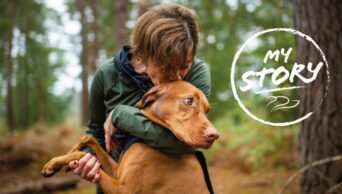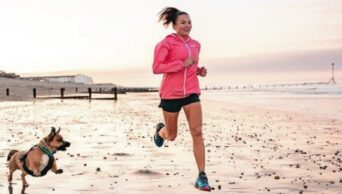can gundogs do canicross?
Blog , +1
August 17, 2022
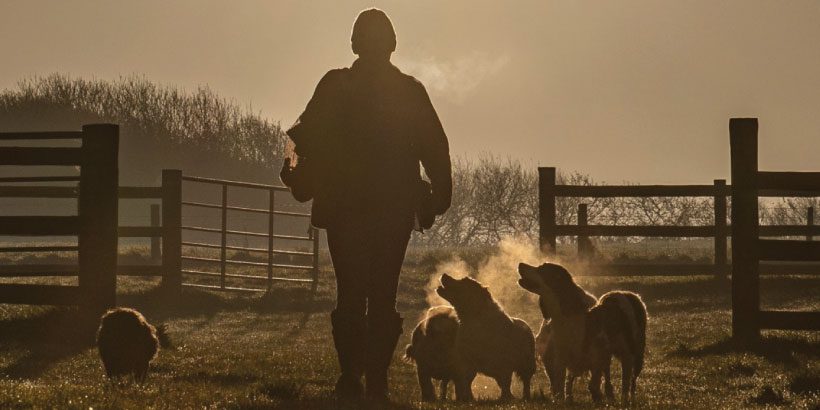
image credit: dogfit uk
Written by DogFit UK
One of the more common questions that we get asked is can any breed of dog Canicross? Are there some breeds that are better at it than others? Our answer is always yes, any dog can do Canicross. However, we do find that there is one particular dog group that we know takes to the sport really well.
The gundog group make popular family pets and are known as reliable, loving companions. However, they are very active and can get easily bored if they are under-exercised and not using their heads. From spaniels and pointers to vizslas and Labradors, we’ve enjoyed introducing gundogs and their owners to the sport.
In our latest Podcast interview we talk to Michelle Osman is a professional gundog trainer and expert handler.
Having gained many field and trial test awards from running her spaniels in the shooting field, Michelle is now running with her dogs herself and Canicrossing. We’re really keen to learn more about how well the two interests work together.

Hi Michelle, tell us about yourself and your background?
I am a gundog and companion dog trainer based in Cornwall, just outside Bude. We moved there about 20 months ago from the Cotswolds. I have a corporate background and have worked with dogs for most of my life. A while back, I decided that working with dogs and training them was what I really wanted to do. So, I became a full-time trainer and set up my own business in the Cotswolds. I’ve also worked dogs in the shooting field, as well as competing in field trials and tests.
While I was doing that, it became really obvious to me that the gundog breeds have become really popular for various different sports, including Canicross, as well as to keep as pets. When we moved to Cornwall, I saw that there was just as much of a need there for my type of gundog training as there had been in the Cotswolds. As people escaped to the country from London, they would typically buy a house first and then a Labrador.
We ended up with a lot of gundogs around us. People were taking them to standard forms of companion training and realising that they needed something extra. I realised that an awful lot of what I had been doing in the working gundog world was also very relevant to the pet dog world. My passion for taking gundogs and turning them into healthy happy household pets grew from there. I started training people to do the same. The key word is training ‘people’, not dogs. I teach people about their dogs.
What dogs do you have?
Currently, I have three spring spaniels and two cocker spaniels. Prior to that, I used to have up to ten or 15 dogs at a time. When you’re working dogs in the shooting field, you need to have a lot of them! I have owned a variety of breeds, from golden retrievers to Labradors… I used to have a few pointers too, but because of the type of work involved, it was easier to work with spaniel and retrievers instead. I’ve even owned beagles for my sins!
Are your current spaniels all working dogs?
When we moved to Cornwall, we had to downsize. I was moving my dogs from living in large kennels with lots of room to having to cope with a small Cornish cottage. So, I had to downsize the number of dogs we took with us as well. The five we have now got include a 13-year-old spaniel who runs the household – she’s deaf and virtually blind, but comes out every day for a walk as long as she knows where she is going. I then have my stud dog, Pip, who is a seven-year-old English springer spaniel and I also have his nephew, Ace, who is coming up on four years old this year. He’s the baby of the family. We then have two cocker spaniels who are ten and eleven years old and called Alfie and Lily.
It’s weird, you know. When you’ve had so many dogs, it is strange to suddenly only have five. You are constantly looking round for the others. But it’s lovely to have them!
It’s such a big world, the gundog world. Before getting so involved with Canicross, I did gundog training with my pointers and there are so many different breeds that are doing it. They really do need different training to the standard obedience classes because the dogs are hugely intelligent and active ands they need something to keep them occupied.
As humans, we have specifically bred different dog breeds to do specific jobs for us. We have taken dogs like short-haired pointers and got them to range over great distances, teaching them how to hold and point, ready to flush. Then, we’ve got spaniels that we have bred smaller and smaller into the working cocker spaniels that were so-named because they were bred to work with woodcock and to be tenacious. We have got Labradors that work seemingly miles away across a field from you. We have taken these breeds and given them specific jobs to do. If you don’t tick those boxes when training them, it can become very frustrating for the dog.
That’s what I try and do with my training work. I look at what we have bred the dog to do, work out what buttons it needs to push and then help the owners to push them in the most convenient way for them. It might be teaching the dog to hunt for food in the garden; it might be teaching it to hunt for rabbits if they are going to work the dog. It’s about taking the traits that have been specifically bred into the dog and not trying to switch them off, but rather acknowledge them and find avenues to extend them further.
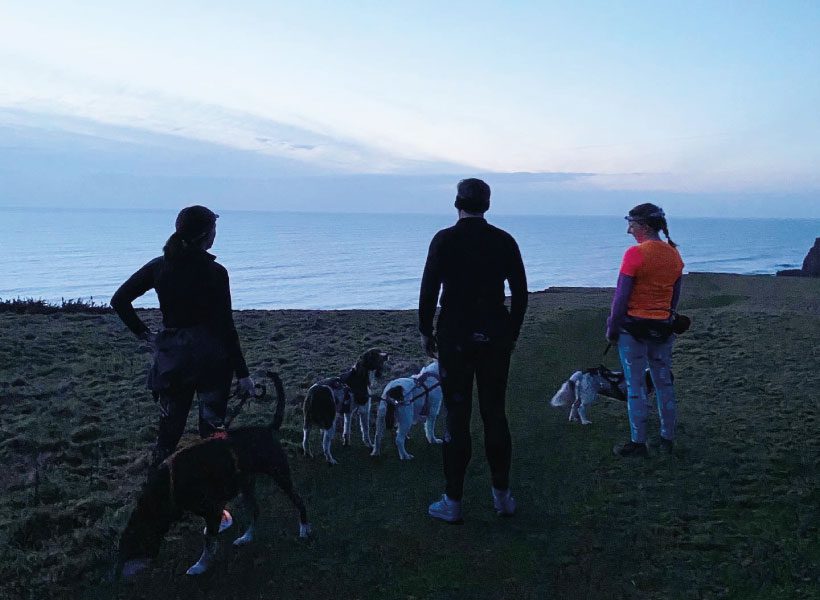
Tell us about your journey into Canicross? You’re working the dogs and running them as gundogs, and then suddenly, you’re out Canicrossing with them yourself!
During the pandemic, shooting came to a stand-still. We had moved down to Cornwall, I had downsized my brood of dogs and was new to the area. I only had one or two dogs that were still at the right age for working and was wondering what to do next. I had a lady come to me for some lessons with her pointe and we got talking about Canicross. I was looking for something to do with my youngest dog in particular.
He has dysplasia and I needed something to keep him occupied that would not cause him to go lame. His dysplasia is in his elbows and by turning his shoulders when running around in the woods, he was frequently causing lameness. I wondered whether putting him in a harness to keep him straight could help. So, I did so and started to run with him. Since our first Canicross run back in August of last year, he has never had a day’s lameness. He runs 5K with me most weeks with no problems at all.
I’d like to clarify though, that while he has had no lameness or problems, I have had plenty! I’ve never been a runner, so to take this sport up at the age of 57 has been a bit of a shock to my body!
Did he run in a straight line straight away?
Yes. I run him in a pair with my other big springer, his uncle. The first thing we noticed about the set-up was that they both immediately started to pull. They enjoy running as a pair and have started to track the same steps. We’ve got pictures of me running with them, where they both have their front left legs lifted, about to strike back down. They are in perfect unison. It’s absolutely lovely to run with them and to have the very real powerhouse of two 20kg springers up front.
As for me, I’m not doing badly for someone of my age who has never run before. I’m just about knocking on 30 minutes for my 5K times now. My running style does need a bit of work, though.
Our customers often ask us whether trying Canicross is going to undo all the hard work they have achieved during training, getting their dog to come to heel and so on. Will they buy a Canicross harness, head on out and then find their dogs starts to pull all of the time? How does your gundog training translate to how you approach Canicrossing?
I think it complements it perfectly. Unbeknownst to a lot of people, when dogs are working in the shooting field, they have to be very calm, sit quietly and then go out and do things very quickly. The analogy I use is that we’re taking dogs to Disney World and then asking them to do maths homework whenever we take them shooting. We’re asking them to have that calmness, but they must also be always listening and ready to go. What I have found with dogs in many different disciplines is that they understand unforms. When my dogs go into their harness, they are in their Canicross running uniform. When they go into their slip lead, that is their gundog uniform.
Should I ask my dogs to come to heel when they are in their harness they will do so because they know the command. I actually use the ‘heel’ command when I am going down hills. A lot of people use ‘behind’, but I know that my heel work means that my dog’s nose will sit slightly behind my legs. Even though my dogs are in their harness, they still recognise the ‘heel’ command. If, on the other hand, they are in their slip leads, they wouldn’t dream of pulling because they have never learnt to pull in that particular uniform.
People ask me if dogs really can recognise this demarcation. I tell them go and put their running shoes on and then tell their dog they can’t come with you. Very quickly, your dog will realise what clothes you are wearing and will be right there, ready to go outside with you. If you put on a different outfit, one that you only wear when you don’t take your dog out with you, it will go into its basket and not try to tag along.
As long as you have a key way for your dog to be able to tell the difference, such as the harness going on or your clothes looking different, most will be able to distinguish between being a well-behaved gundog and becoming a fast, strong-pulling Canicrossing dog.
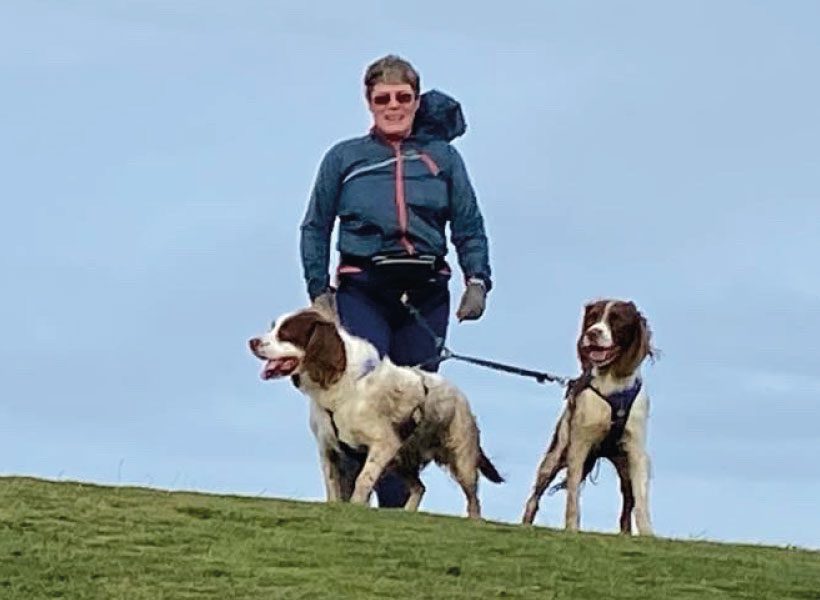
On the subject of uniform, when it comes to getting your dogs used to wearing a Canicrossing harness, do you have any tips?
I always start by getting dogs used to having something put over their heads, be it a harness, slip lead or drying coat. I work in the same way as I used to with ponies. I put the harness halfway up my arm and have a treat in my hand. As the dog’s head moves to my hand to take the treat, I move the harness down my arm and over the dog’s neck. It doesn’t get done up. It just lies there. I then get another treat out and take the harness off. I do this multiple times so the dog can get used to the fact that the harness is coming on and off and that something good happens every time. Then, I might clip up just one side of the harness, unclip it and give the treat.
My form of dog training is about making everything a positive experience. I want my dogs to think, every time the harness comes out, ‘oh my goodness, I want to put that harness on! Not just because I’m going running, but because I get a treat every time it goes on.’ Even now, my dogs get a treat whenever the harness goes on. It’s always got to be a positive experience.
When you’re out in the shooting field it’s all about self-control, steadiness and having your dog completely at your command. Canicross is a high-energy, exciting sport, especially at the start of an event. If someone starts Canicross with their working gundog, will that affect its ability to focus once it is back in the field?
No, I don’t think so. My dogs sit quietly by my side at the start of any event. They are calm because I have taught them calmness. This is very important. I want my dogs to be in what I call a rational brain, not an emotional one. Even when you are running with your dogs, you want them to still be able to listen to you. You want them to hang on your word. You need to be able to give them instructions, not just for your own safety, but for theirs as well.
If you have the chance to walk the course in advance, you know what you have ahead of you. You know where there is going to be a large drop coming up in front of you, for example, when you really need your dogs to be listening to you and not pulling on. If we can teach our dogs to stay in that rational brain, even when they are pumped up and ready to go, it will be safer for you, there will be fewer injuries for your dog and it can actually improve your overall time. The dog is concentrating properly, rather than thinking ‘woo-hoo, this is great, let’s all go and have a party!’
When you’re running with a gundog – or indeed any dog – always keep them in the mindset that they are working with you. Even if they are slightly excited inside, keeping them calm and ready to listen is key. As humans, we all know the excitement that can overtake a rational brain. When those Rolling Stones tickets arrived in the post for me, I was unable to do anything for about four hours – even make a cup of tea! I really couldn’t think straight.
I’m a keen pusher of the rational brain and training gundogs to use it. I want my dogs to be able to sit off-lead next to me while thousands of birds are flying around them, other animals are in front of them, people are whooping, beaters are coming past them and there’s lots of banging and noise. They just have to sit there and wait for their command. A dog that can do that is a safe dog. It is fit to work and will not run off and do something stupid. We’ve all seen it, especially with young puppies that go running into a wall because they’re not thinking about where they are going. You’re waiting for the crash to happen.
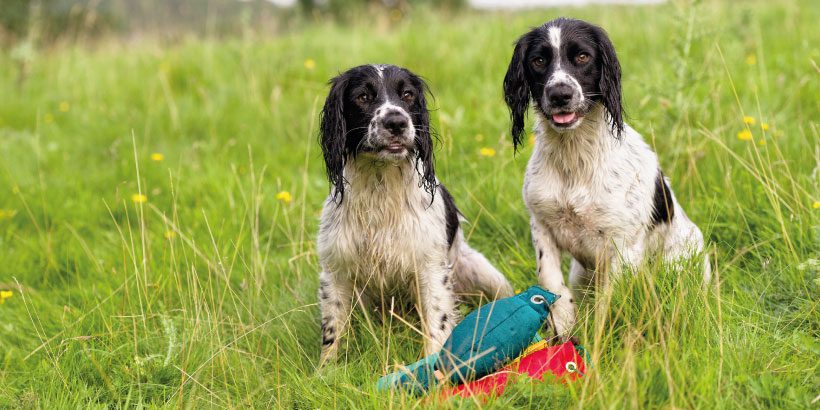
Have you seen a difference between dogs who come to you for training who are fitter than others and how this affects their ability to do their job?
Totally. If we are fitter and healthier, we learn things quicker and it’s the same for dogs. Healthy, fit dogs are keen to learn and much better at listening. Dogs aren’t stupid. If they are not fit, they lie down and refuse to do things, often because something hurts. Pain can come from lots of different things. If you’re not fit and healthy, however, it will arrive a lot faster. Training an unfit dog puts you in the position of having to get it to do something it doesn’t want to do. That’s the wrong approach entirely. If a dog is fit and healthy, it will pick up anything you’re trying to show it quickly and easily. It will have both the mental and physical capacity to do it.
When a dog is out on a shoot all day it has high endurance levels, it is being steady and attentive all day. That’s a lot of activity for it. If you took that dog and started Canicross with it, you would still need to train and prepare it for different endurance levels.
Absolutely. When I first took up Canicrossing, I started a Couch to 5K training programme, which proved to be the perfect start for my dogs as well. My dogs are sprinters and can work for or five drives on any shoot day. This means that they would only be active for twenty minutes maximum per drive. The rest of the day could be spent sitting on their backsides or waiting in the truck. So, they might know how to sprint for shorter time spans, but when I ask them to run for longer, it involves a lot more endurance work. It’s asking their bodies to do a totally different physical activity.
Any dog that takes up Canicross is starting a whole new fitness regime, whatever breed they are. Most of us couldn’t just go out and run a full 10K from scratch so why should we expect our dogs to do similar? Whatever discipline your dog has come from, be it gundog, ability dog, pet dog, rescue dog… you have to start from the basics and build it up.
We talk to people all them time about this. They take their dogs out free running for an hour all the time, but just half an hour of Canicrossing can be a very different story and a greater strain on the dog’s body and mind.
It’s also about the surfaces we run on. We have to think about that. There is one running trail local to me that I love doing. My youngest dog – the one with dysplasia – will always get himself up onto the grassy bank rather than staying on the stony track because he prefers running on the softer grass. When people go out pounding tarmac roads with their dogs, they have to think about what they are doing and how it is affecting their dogs.
We never advise running on roads. You might have to do a short distance to get up onto the Canicross trails, but any longer than that is not a good idea. During warmer months, too, people don’t think about the higher temperatures that tarmac can reach.
Yes, weather is key. There’s a reason why the shooting season is when it is. Not only when the birds are there, but it is when the conditions are best for the dogs. A gundog may have to work during the winter months in cold, wet, miserable weather when we need to keep it warm and dry between drives. However, its body can heat up so quickly when it runs and then take a long time to cool down. So, monitoring outside temperatures is very important indeed.
We always talk about both the physical and mental benefits of Canicross and how it can help you form a strong bond with your dog. How have you found the sport as a way to build on your relationship with your own dogs?
It’s brilliant – the ultimate way to bond with your dog. Gundog training and agility work are great, but Canicross gets you and your dog out on your own, in the middle of nowhere to run in beautiful surroundings. When I go out running with my dogs and they love it – they smile the whole way round! They love being with me, doing something they enjoy and knowing that it’s pleasing me too. The dog really does become in tune with you. There’s nothing nicer than being at the bottom of a hill and giving your dog a command to turn left and he does so. People look, and you feel really smug!
It’s that whole thing of being physically attached to the dog like an umbilical cord. It has to be team work so that everyone runs the same way. Running with two springers, if they decide to stop, it could get messy. Or if they are on a split line and one dog decides to go one side of a tree and the other runs on the other, it could get even messier… You’ve got that physical connection, but also the emotional one that comes with working as a team.
You have already touched on this, but one of your dogs has got dysplasia. How has Canicross helped him in particular?
If that dog had not taken up Canicross, I don’t know what his future would have looked like. He was diagnosed when he was very young. His elbow joints never formed properly and they stick out really far now. The problem is that they can pop out of place quite easily. As a spaniel, he was designed to hunt by turning quickly on the spot to keep pace with the animal. If he actually did that, however, he’d be popping his joints out all the time. He’d be constantly in pain. No-one wants a dog to be like that.
Finding something that he can do that not only strengthens our bond, but stops him being in pain, keeps him fit and gets him out, is a really good thing. He’s a feisty little character. He’s very speedy and loves to run. Canicross ticks all these boxes for him, but most importantly, it’s given him a purpose. Even as a pet, I couldn’t let him off the lead when I walked the other dogs. He would be the one who wanted to climb the banks and jump off them. He always has to be on a lead of long line to keep him safe.
Now, he has a purpose in Canicross. He loves getting into his harness, even for walks. He has a red one for his walks and a blue one for racing in. He already knows the difference. People say that dogs don’t see colours but he seems to be able to work out the difference. Maybe they fit slightly differently. If I put his red one on, he comes and sits next to me to have his long line attached. If I choose the blue one, he is chasing around the house for ages because he is raring to go!
That’s so nice that he has a purpose and something special he can do with you that the other dogs don’t do. I love how you describe his smiling as he runs with you.
He really does! In the gundog world, a dog making noise is a no-no, especially during competitions. I’ve driven three-hundred miles only to have my dog squeak at the wrong time, making us have to turn around and go back home. So, they’re used to not making a sound. When I put the Canicross harness on my dogs, however, they make these little satisfied sounds that are lovely to hear.
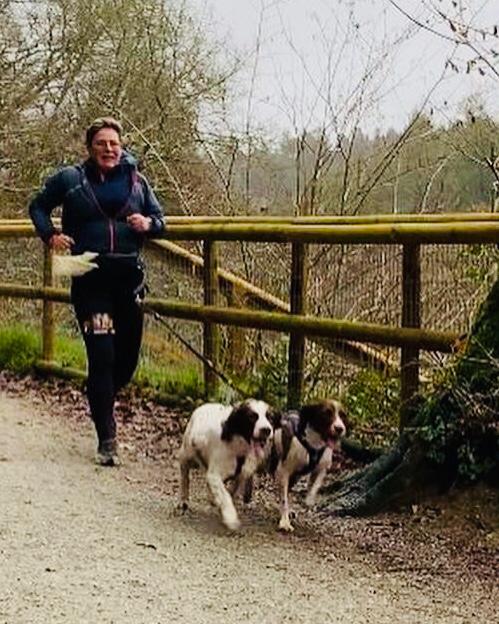
How has Canicross helped you?
It’s given me a purpose too. When we moved to Cornwall, I decided not to work quite so hard as I had been doing. The pandemic also forced that decision upon me. I was looking for something new to do with my time – at the age of 57 I wasn’t quite ready to hang my boots up altogether! When you’ve got dogs, you can’t put them under the stairs and forget about them. As I have five of them, I needed to find different things to do with each of them according to their characters and their likes and dislikes. My older ones are very happy with beach walks and things like that. However, my younger boys needed something more active. So, I started Canicrossing for my younger dogs to begin with. However, I don’t know where I’ve been for the past 57 years! While I am not built for running and will never be a threat to Mo Farrah, I really enjoy it.
More importantly, I have found a whole new community of people that love dogs, love running and even more than that, love to share a good breakfast after a run. We have a really good social group here and we meet up during the week for runs with breakfast or lunch included – there’s always food involved somewhere! It’s made the whole thing really nice for me. I would probably have never met many of the people who come along to our meet-ups in any other context – what connects us is that we run, and we run with dogs.
That’s all you need sometimes – friends and dogs! I believe you have a funny story about how you used your gundog training skills during Canicross?
Running on the north Cornwall coast can sometimes be a bit blustery. One time, I had a baseball cap on and it flew off, right down this rather steep valley. About 150 yards later, it landed at the bottom. Everyone stopped and offered to wait for me while I ran down to get it. I said that there was no way I was going all the way down there. I clipped my dog, lined it up and told it to go and get my hat. It ran straight down, picked up the hat, brought it back up and sat back down in front of me.
I put my hat back on my head, repositioned the dog and off we went again. People just stood there with their mouths open! There’s a saying, don’t have a dog and bark yourself! Part of my training methods with dogs is to teach them to pick things up and return them. It’s a key part of training for assistance dogs. For my dog going to collect my hat is something we have done many times. He can pick up my mobile phone too. So, if I lose it, I’ll say ‘phone’ and my dogs will go and hunt for my phone for me.
It’s just one of those things. What made the hat incident so funny was the look on people’s faces. They thought they were going to get a bit of a break from running while I walked down the hill and back up again, but instead I sent the dog who fetched it in no time at all!
What advice would you give to anyone considering giving Canicross a go?
Go for it! Find someone to run with who will show you the ropes. Make sure you find someone who can help you get the right kit for your dog. The dog is the most important part in all of this. What we do to ourselves is our choice. What we do to our dogs has got to be the right thing for them. Ask someone to teach you about the commands and what to do.
Learn about the etiquette. If you’re running in areas that attract large numbers of tourists, as we do in Cornwall, you must lead the way when it comes to showing manners and respect. You must be the ones to stop and move to the side to allow others to pass. Twenty dogs and twenty runners can’t just plough through a group of people who have come on a bus trip to Bude for the day. That is a really important part of what I call the rules of Canicross.
Finally, the social aspect is so much fun. I came from the gundog world where everything takes ages to do. If I had a competition, I would be up and out by 4am and wouldn’t be home again until the evening. Now, I can go out at 8am, meet up with friends, have a run and some breakfast and be back home by 10.30am. It’s not going to eat up your whole day.
In your opinion, then, a highly trained gundog won’t be ruined by taking up Canicrossing.
Absolutely not. It really complements gundog training. We’re very bad at putting dogs into little boxes and saying that if you have a gundog, they can only do gundog things. Why? Humans don’t just do one thing – we have lots of interests and hobbies. So long as you have trained your dog properly and have something that demarks the uniform of Canicrossing and other forms of training or physical activity, then I can’t see there being a problem.
Many gundog people already take their dogs running off-lead to prepare them for the shooting season. They are using running as a way to increase their dogs’ fitness levels. It doesn’t take much more to tie the two together and have a go at Canicrossing.
Finally, what’s next for you in your Canicrossing journey?
I have been doing a training programme to get to 10K. I’ve run three or four 5K races, coming in at under 35 minutes each time. Running two dogs has been a challenge, so I may have to start running them separately if I want to achieve the longer distances. Some 10K races only allow you to run one dog at a time, rather than two. My next goal is to get myself feeling fully fit again after a recent bout of COVID and then get back out running and resume my programme for the 10K. Next season, I want to hit sub-30 minutes for my 5K and I want to be able to safely complete a 10K.
If you would like to hear the podcast with Michelle, you can find it here.
Michelle’s training business is called Mapowders and you can find this here

